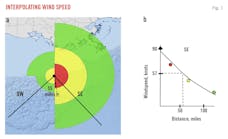EPA releases draft findings from Pavillion, Wyo., groundwater probe
This article was updated on Dec. 9
The US Environmental Protection Agency reported that its investigation of groundwater in Pavillion, Wyo., found chemicals consistent with natural gas production and hydraulic fracturing fluids there. EPA began investigating water-quality concerns in private drinking water wells 3 years ago at residents’ requests in the West-Central Wyoming community, about 20 miles northwest of Riverton.
Since that time, EPA said, it has worked with Wyoming state government officials, local residents, and EnCana Oil & Gas (USA) Inc., the gas field’s owner, to assess groundwater quality and identify potential contamination sources. Its Denver regional office released a draft analysis of its data for public comment and independent scientific review on Dec. 8.
Wyoming Gov. Matt Mead (R) immediately responded that EPA’s draft looks scientifically questionable and more testing is needed. “We believe that [it] could have a critical impact on the energy industry and on the country so it is imperative that we not make conclusions based on only four data points,” he said. “Those familiar with the scientific method recognize that it would not be appropriate to make a judgment without verifying all of the testing that has been done.”
EPA said samples from two deep monitoring wells it constructed to reach the aquifer detected synthetic chemicals, like glycols and alcohols consistent with gas production and fracing fluids; benzene concentrations well above federal Safe Drinking Water Act standards; and high methane.
“Given the area’s complex geology and the proximity of drinking water wells to groundwater contamination, EPA is concerned about the movement of contaminants within the aquifer and the safety of drinking water wells over time,” it said.
Other findings
EPA said it also updated its sampling of Pavillion area drinking water wells and found chemicals consistent with its earlier samples including methane, other petroleum hydrocarbons, and other chemical compounds. The chemicals’ presence was consistent with migration from gas production areas, but at levels below established health and safety standards.
It noted that the US Department of Health and Human Services reviewed data from EPA’s earlier sampling in the fall of 2010 and recommended that affected well owners take precautions including using alternate water sources for drinking and cooking, and ventilation while showering. The recommendations remain in place and EnCana has funded provision of alternative water supplies, EPA said.
It said it shared preliminary data and the draft report with state officials, EnCana, Indian tribes, and Pavillion residents before releasing the findings publicly. Comments will be accepted from the public for 45 days and the peer review by independent scientists will last for 30 days, according to EPA.
Lack of replication
Other Wyoming officials said EPA’s findings were based on data from two test wells deeper than drinking water wells, which were drilled in 2010 and tested once that year and once in April 2011. The data were not available to other members of the working group investigating the matter until a month ago, they said on Dec. 8.
They said they and other working group members specifically questioned the lack of testing replication since findings from two sampling events typically suggest that more sampling is needed before conclusions can be drawn. They added that working group members also raised questions about the presence of the compound 2-BE, which was found in one of the four samples, and why it appeared in results from one laboratory while other labs tested the exact same water sample and did not find it.
“More sampling is needed to rule out surface contamination or the process of building these tests wells as the source of the concerning results,” observed Tom Doll, the Wyoming Oil & Gas Conservation Commission’s supervisor and a member of the Pavillion working group.
“We do not want to predetermine the outcome of further research, but do feel the need for more thoroughness. I want to know what happened in Pavillion and feel the responsible approach is to do more testing,” Mead said. “What we do know is that there has not been fracing in this area for several years, and that there have been significant changes in our drilling regulations since then. Wyoming has led the country in regulating fracing because we want to protect our people, protect the environment, and bring energy to the nation. More research will only help us.”
“We would welcome a true peer review outside EPA. We want the facts to get out,” a spokesman in EnCana USA’s Denver office told OGJ on Dec. 9. “The ultimate goal is for the folks in Pavillion to have a good source of drinking water.”
Contact Nick Snow at [email protected].

Nick Snow
NICK SNOW covered oil and gas in Washington for more than 30 years. He worked in several capacities for The Oil Daily and was founding editor of Petroleum Finance Week before joining OGJ as its Washington correspondent in September 2005 and becoming its full-time Washington editor in October 2007. He retired from OGJ in January 2020.

